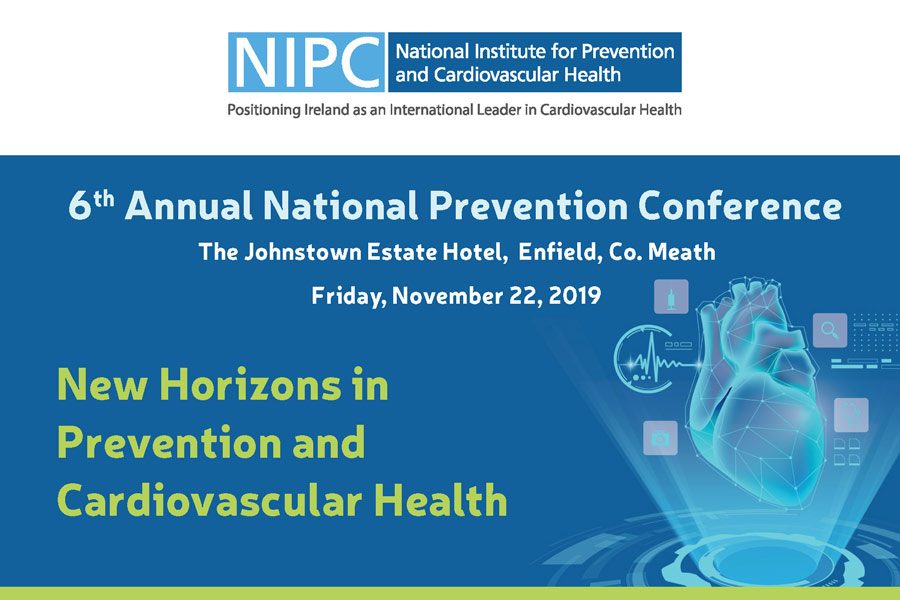


6th Annual National Prevention Conference
Sep 16, 2019
The National Institute for Prevention and Cardiovascular Health are delighted to announce the 6th Annual National Prevention Conference 2019. Join leading experts in CVD Prevention on Friday November 22 at the Johnstown Estate Hotel, Enfield, Co Meath and get the...
Unique Collaboration Brings World Leaders In Heart Health To West Of Ireland
Sep 16, 2019
A strategic partnership between local heart & stroke charity Croi and NUI Galway is leading the way in positioning Ireland as an international leader in cardiovascular health. In 2014, Croi set about putting Galway on the map as a centre for leadership in the...Recent Posts
Archives
- June 2025
- May 2025
- April 2025
- March 2025
- February 2025
- January 2025
- December 2024
- November 2024
- October 2024
- September 2024
- August 2024
- July 2024
- June 2024
- April 2024
- March 2024
- February 2024
- December 2023
- November 2023
- October 2023
- September 2023
- July 2023
- June 2023
- May 2023
- April 2023
- March 2023
- February 2023
- January 2023
- December 2022
- November 2022
- October 2022
- September 2022
- August 2022
- June 2022
- May 2022
- April 2022
- March 2022
- February 2022
- January 2022
- December 2021
- November 2021
- October 2021
- September 2021
- August 2021
- July 2021
- June 2021
- May 2021
- April 2021
- March 2021
- February 2021
- January 2021
- December 2020
- November 2020
- October 2020
- September 2020
- August 2020
- July 2020
- June 2020
- May 2020
- April 2020
- March 2020
- January 2020
- November 2019
- October 2019
- September 2019
Categories
Prof. J. William McEvoy – US National Library of Medicine National Institutes of Health
CONCLUSIONS: The vast majority of patients with CHD have Lp(a) levels far below what is considered a typical risk-enhancing threshold, suggesting that the attributable risk from Lp(a) is more complex than previously perceived. Furthermore, wide geographical variations in Lp(a) levels above entry criteria for ongoing trials could impact equitable access to therapies, if these trials are positive.
BACKGROUND: The Dietary Approaches to Stop Hypertension (DASH) diet is designed to lower blood pressure and improve cardiovascular health by reducing sodium and unhealthy fats while increasing nutrients, including potassium, calcium, magnesium, and fibre. While evidence supports its benefits for managing cardiovascular risk factors, gaps remain in understanding its long-term impact on preventing cardiovascular disease (CVD), particularly in terms of hard clinical outcomes such as myocardial...
CONCLUSIONS: HTG and residual combined dyslipidemia are common, although with wide variability between countries. A healthier lifestyle, weight reduction, greater use of combination therapy, and evidence-based TG-lowering treatments are necessary to reduce the risks of HTG and combined dyslipidemia.
CONCLUSIONS: The differences in NT-proBNP by age, sex, and race or ethnicity in younger persons mirror those seen in adults. These results suggest that as in adults, levels of NT-proBNP should be interpreted in children and adolescents based on these demographic and clinical factors.
The level of evidence (LOE) grading system for European Society of Cardiology (ESC) Clinical Practice Guidelines (CPG) classifies the quality of the evidence supporting a recommendation. However, the current taxonomy does not fully consider the optimal study design necessary to establish evidence for different types of recommendations in ESC guidelines. Therefore, two separate task forces of clinical and methodological experts were appointed by the CPG Committee, with the first tasked with...
In 2024, the European Society of Cardiology released a new guideline for the management of elevated blood pressure (BP) and hypertension. The guideline introduced a new BP categorization: (1) nonelevated (office BP <120/70 mm Hg) for which drug treatment is not recommended, (2) elevated (120-139/70-89 mm Hg) for which drug treatment is recommended based on cardiovascular disease risk and follow-up BP level, and (3) hypertension (≥140/90 mm Hg) for which prompt confirmation and drug treatment are...
Genome-wide association studies have revealed hundreds of genetic variants associated with cardiovascular diseases (CVD). Polygenic risk scores (PRS) can capture this information in a single metric and hold promise for use in CVD risk prediction. Importantly, PRS information can reflect the causally mediated risk to which the individual is exposed throughout life. Although European Society of Cardiology guidelines do not currently advocate their use in routine clinical practice, PRS are...
CONCLUSIONS: There is considerable opportunity of further reduction of cardiovascular risk in Polish patients treated for coronary artery disease. A revision of the ongoing and more intensive endorsement of cardiovascular prevention programs is advisable.
While digital cardiac rehabilitation (CR) is an effective alternative to center-based CR, its components and mechanisms of change remain poorly understood. The Multiphase Optimization Strategy (MOST) provides a framework that allows the effects of individual components of complex interventions to be studied. There is limited guidance within MOST on how to develop a conceptual model. This article describes the development of a conceptual model of digital CR. The conceptual model was developed...
CONCLUSIONS: The MIAMI intervention was considered largely acceptable and feasible. Some changes to both intervention components and trial processes are required but with these in place a definitive RCT could be considered worthwhile.
CONCLUSIONS: Within the included diastolic BP range, there was no evidence that baseline diastolic BP modified the beneficial effects of intensive BP lowering.
CONCLUSIONS: Combining behavior change theory with a person-based, co-design approach facilitated the development of a DHI for the secondary prevention of CVD that optimized responsiveness to end users' needs and preferences, thereby potentially improving future engagement.
CONCLUSION: The study findings suggest that factors influencing implementation of digital CR operate at multiple levels. Therefore, multi-level implementation strategies are required if the true potential of digital health in improving equitable cardiac rehabilitation access, participation and patient outcomes is to be realised.
Climate change is a public health crisis predominantly due to fossil fuel combustion, that challenges planetary and human health. Considerable evidence exists to demonstrate the impact climate change has on cardiovascular disease primarily through air pollution, and non-optimal temperature. Conversely, healthcare systems themselves contribute substantially to climate change. Many clinicians personally report a sense of responsibility to reduce the detrimental impact of parts of our healthcare...
CONCLUSION: In a large cohort of individuals with CAC = 0, the rate for incident stroke was low (2.0 per 1000-person years) and was associated with modifiable risk factors.
CONCLUSIONS: This IPD analysis of three large RCTs found blood pressure reductions with semaglutide in participants with hypertension that were similar to those seen in all trial participants. This finding may in part be due to concurrent reductions to anti-hypertensive medications. These results suggest that semaglutide is a useful adjunctive treatment for patients with hypertension and obesity.
CONCLUSIONS: The SCORE2 Asia-Pacific algorithms have been calibrated to estimate 10-year risk of CVD for apparently healthy people in Asia and Oceania, thereby enhancing the identification of individuals at higher risk of developing CVD across the Asia-Pacific region.
CONCLUSIONS: INTERASPIRE demonstrates inadequate and heterogeneous international implementation of guideline standards for secondary prevention in the first year after CHD hospitalization, with geographic and sex disparity. Investment aimed at reducing between-country and between-individual variability in secondary prevention will promote equity in global efforts to reduce the burden of CHD.
The global prevalence of obesity has more than doubled over the past four decades, currently affecting more than a billion individuals. Beyond its recognition as a high-risk condition that is causally linked to many chronic illnesses, obesity has been declared a disease per se that results in impaired quality of life and reduced life expectancy. Notably, two-thirds of obesity-related excess mortality is attributable to cardiovascular disease. Despite the increasingly appreciated link between...
CONCLUSION: Estimating uncertainty surrounding individual CVD risk predictions using Bayesian methods is feasible. The uncertainty regarding individual risk predictions could have several applications in clinical practice, like the comparison of different treatment options or by calculating the probability of the individual risk being below a certain treatment threshold. However, as the individual uncertainty measures only reflect sampling error and no biases in risk prediction, physicians...
When the consultation is predominantly verbal, existing research in clinician-patient communication indicates that many patients struggle to understand and recall medical consultations or may not understand the extent of their illness or the purpose of their treatment plan. When the clinician-patient discussion centers around the risk of a repeated cardiovascular disease (CVD) related event, qualitatively assessing what factors affect the communication of this risk may guide the creation of...
CONCLUSIONS: Among patients with CCS and unstable angina, PPMIs defined by SCAI occurred more frequently when using cTnI as opposed to cTnT, whereas the type of troponin had no impact on the incidence of PPMIs according to the ARC-2 and 4UDMI.
Background: Hypertension is one of the most important risk factors for stroke and heart disease. Recent international guidelines have stated that 'poor adherence to treatment - in addition to physician inertia - is the most important cause of poor blood pressure control'. The MaxImising Adherence, Minimising Inertia (MIAMI) intervention, which has been developed using a systematic, theoretical, user-centred approach, aims to support general practitioners (GPs) and people with hypertension to...
CONCLUSIONS: Cardiac biomarkers may be more selective for informing risk-based treatment decisions in stage 1 hypertension, particularly among adults aged ≥65 years.
BACKGROUND: Digital health interventions (DHIs) are increasingly used for the secondary prevention of cardiovascular disease (CVD). The aim of this study is to determine the feasibility of "INTERCEPT", a co-designed DHI developed to improve secondary prevention in hospitalised coronary heart disease patients (CHD).

Recent Comments